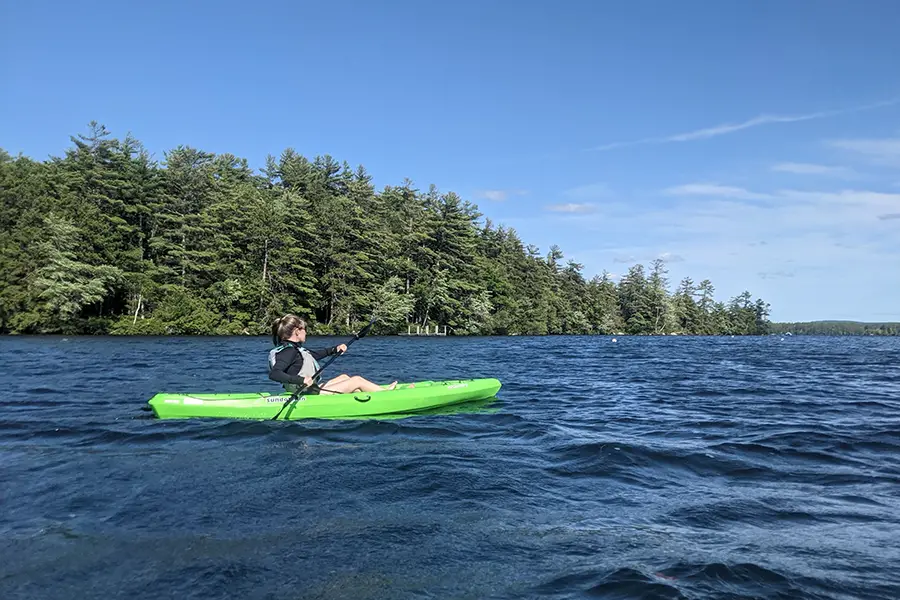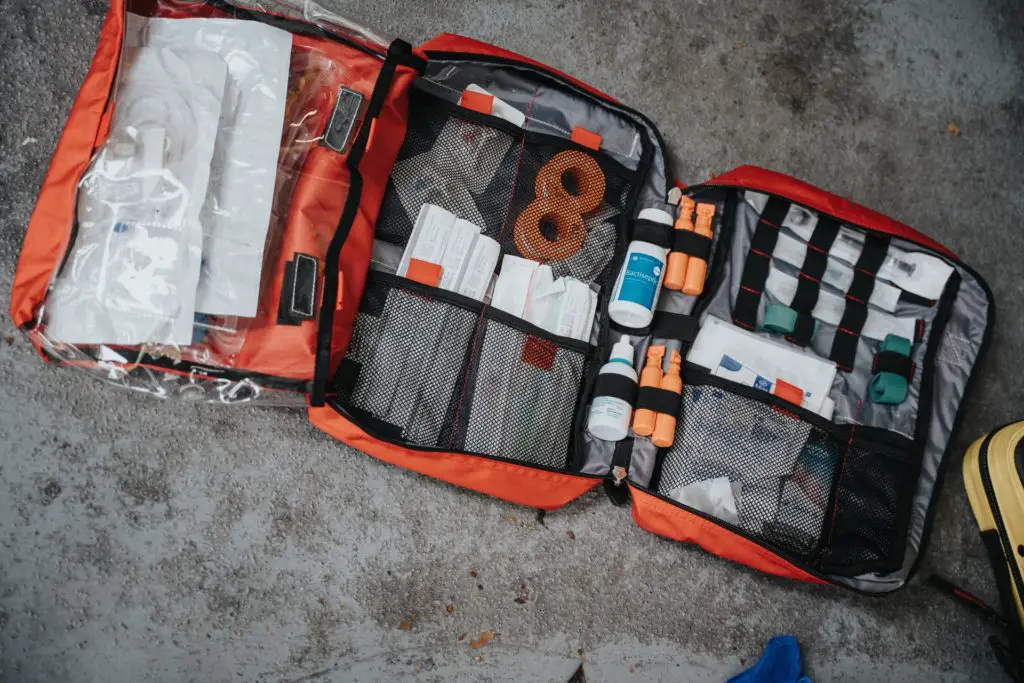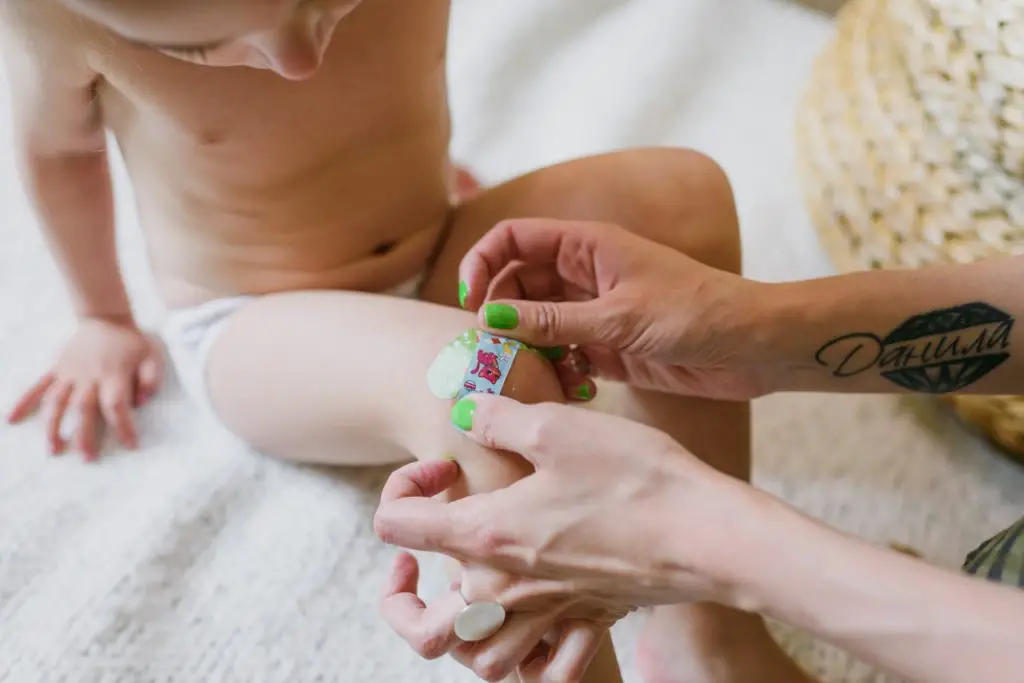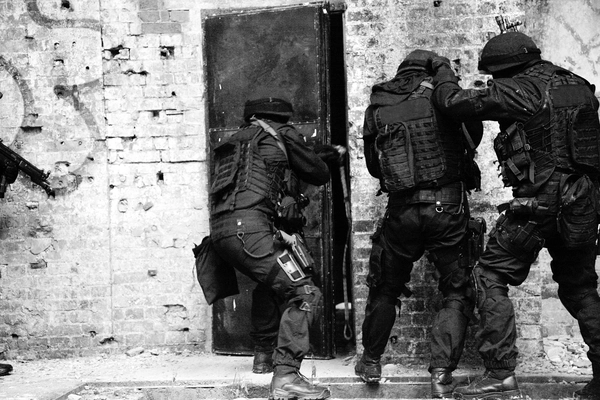Kayaking is becoming increasingly popular, and canoeing is a classic way to easily get out on the water. They offer a low-cost way to explore local lakes and rivers. But there are risks associated with it. Whether it’s the transportation of the equipment or getting caught in a storm and stranded, a first aid kit should be part of your canoe and kayak setup. This article will lay out the typical contents of a first and kit, and make you aware of some other things to keep in mind.
What are the contents of a kayak first aid kit?
- Sunblock. Sunburns are probably the most likely injury to occur while out on the water. Bringing extra sunscreen along is always a good idea in case you forgot protective clothing or to apply sunscreen before you left the shore.
- Lip balm with an SPF rating. You’ll want lip balm for similar reasons as to sunblock. it will help to protect your lips and keep them moisturized.
- Adhesive Bandages. I’d suggest not cheaping out on adhesive bandages getting a name-brand like band-aid really makes a difference On how they stick and how they hold up. it goes without saying that you should get waterproof bandages.
- Antibiotic ointment. You’ll want to apply this to your wound or to your bandage before covering your wound up this will help to keep it from becoming infected and to promote healing.
- Antiseptic pads or wash. You’ll want to clean out any cuts or scrapes before applying a bandage. Antiseptic pads (like alcohol wipes) are a good option that won’t take up a lot of room. An antiseptic wash might be better for deeper cuts, especially if on clean water has made its way into the wound.
- Gauze and medical tape. Gauze is essential for larger wounds or abrasions that cover a larger area. I’d suggest using 3M Nexcare Absolute Waterproof tape to keep it in place, but there are other waterproof tape solutions.
- Moleskin / Leukotape. It’s not uncommon to develop hot spots or blisters when paddling. The combination of water and friction on your skin makes for a perfect perfect scenario. Gloves are always a great option to help protect your hands, but it’s a good idea to keep have a protective tape with you just in case. Duct tape is a great alternative if you want to minimize what you’re carrying.
- Cutters. Can be useful for cutting through hooks for hook removal.
- String. Also for hook removal.
- Tweezers. Splinters from docks, or a tick when walking along the shoreline, are good reasons to consider bringing some tweezers along.
- Medications.
- Motion Sickness Medication (like Dramamine) – Car sickness is common but be warned that some cause drowsiness and that it may not be a good idea for the driver
- Antihistamine (like Benadryl) to calm allergic reactions and can sometimes help with motion sickness
- Ibuprofen / NSAIDS for pain relief and inflammation
- Aspirin for pain relief and fever reduction
- Pepto-Bismol for diarrhea, upset stomach, nausea, and heartburn
- Nitrile Gloves. Your hands can be covered with unknown bacteria so be sure to bring some gloves to protect your wound or to protect yourself from others yes providing first aid for someone else.
- Triangle bandage. Relatively small and can be used as a sling, to help splint a broken limb, to wrap major wounds or around the head, or as a tourniquet. Make sure to have safety pins as well.
- Guidebook. Having a small first aid pocket guide is always a good idea. Even with formal training, you may forget the essential steps to providing aid to someone else or to yourself.
Tip: Make two kits: one to keep in your PFD and one to keep one secured away elsewhere. Keep things like sunblock, medications, or other items you will be most likely to access in your PFD kit.
Choosing a case for your FAK
The case you choose is one of the most important choices you’ll make about your first aid kit. No matter how hard you try, things tend to get wet in a kayak or canoe, so make sure you have a case that is waterproof. I also use zip lock bags within the case for redundancy and organization, especially for items that may become damaged if wet. Some common options are:
- Dry bag. You probably already have some if you paddle on a regular basis. The flexibility allows it to be packed in awkward-sized spaces and is more comfortable if carried in another bag. Dry bags are obviously less durable and are susceptible to rips and punctures. They also don’t usually hold up if submerged for more than a couple of seconds. A good option is this Sea to Summit dry bag.
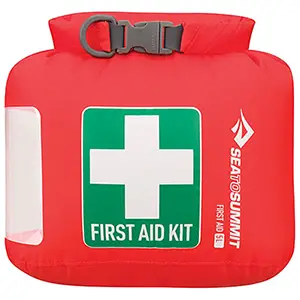
- Tackle box. If you’re a fisherman you might consider using one of your tackle boxes as a dedicated first aid/emergency kit, That way you’ll never forget it. Make sure to get one that locks securely and is watertight.
- Hard waterproof cases. These can be purchased for fairly cheap from a big box store or online. They are usually extremely durable, can take a beating, and will float if it were to fall out of the boat. Plano is a trusted name in fishing gear a makes a good, clear, waterproof case in several sizes.
Emergency & Survival Items for your kayak or canoe
You can put together a small survival kit that will take very little room in your kayak or canoe. This can be scaled down for trips on popular lakes or rivers where seeing others is common, or should be added on to if going on a multi-day trip down a remote river.
- Whistle. Required by the US Coast Guard to signal in an emergency.
- Lighting. There are a few types to consider:
- Navigational type lights are required by the USCG.
- Headlamp for general lighting while fishing and paddling.
- Small SOS light that attaches to your PFD and flashes in an emergency.
- Glowsticks can also be good in an emergency.
- Water filtration. All of that time in the sun can lead to dehydration faster . Bring a method of filtering water in case you are stranded for a long period of time.
- Toilet paper. Sometimes nature calls and you’ll need to pull off somewhere to take care of business. You’ll be glad you have it if you need it.
- Fire starting kit. Making a fire isn’t only required if you’re going to be stuck out overnight; it may be needed if you are wet and need to warm up and dry clothing.
- Emergency blanket. Being wet can lead to hypothermia, even in warmer temperatures. For its size and weight there is no reason to not have an emergency reflective blanket with you. The ponchos versions are even a better option as they keep you covered in windy conditions.
- Poncho. You may already have rain gear with you, but bring a poncho along just in case to keep you dry – it’s a good way to stay warm and comfortable.
- Phone battery. Whether you’re stranded or lost, having a phone is the best way to call for help or look at a map. Have a rechargable battery ready in case your phone dies on the trip.
- Phone number for Coast Guard.
- Multitool. May be redundant if you have your fishing gear, but you should bring one if you don’t.
- Extra rope or line. 550 cord is a good go-to, but a 3 strand nylon rope may be better suited for use in the water.
- Packable towel.
- Duct tape
- Zip ties
Tip: Get a waterproof pouch for your cell phone and wear it around your neck, that way it’s safe, easily accesible for photos, and with you no matter what.
What does the US Coast Guard require?
Coast Guard requirements will vary whether you are on inland waters or on coastal waters. States may have additional requirements, so check your local jurisdiction. The USCG requires the following:
- Personal flotation device. A wearable personal floatation device that is properly fit, in serviceable condition, and marked with an approved label is required. We would suggest wearing your PFD at all times, but it is not required. See Title 33 CFR 175.15, 175.17, 175.21, and 175.23 for more info.
- A whistle or other sound producing device. Your best bet is to keep this attached to your PFD. See Title 33 CFR 83.33 for more info.
- Navigational lights. The typical red and green lights you see on boats aren’t required if it’s not “practical”, but some form of light is. See Title 33 CFR
- If you’re in coastal waters, you’ll need to carry visual distress signals. This might be flares or an electronic distress device.
Kayak Fishing Magazine has aggregated all of the verbiage from Title 33 in this article.
Typical kayak and canoe injuries
Generally, the most serious injuries that occur while paddling are often when traveling two and from the water rather than while you’re in it. A common injury occurs at the rotator cuff or shoulder. When carrying your canoe or kayak, especially when it’s overhead or when removing it from the roof rack, your shoulder is susceptible to injury. Be sure to lift with two people if your equipment is too heavy are use the proper tools to get your kayak from point A to point B safely.
Another common entry is a rolled or sprained ankle. This can occur when portaging, carrying your kayak or canoe over uneven terrain, or when getting in or out of your vessel.
The most common minor injuries that I’ve seen are often preventable ones. Sunburns being the most common, wearing appropriate clothing and using sunscreen are the best ways to prevent it. Remember that the sun reflects off of the water so even with a hat on your face can still become sunburned. I also tend to get hot spots on my hands. Wear comfortable gloves that can get wet and use protective tape or moleskin on hot spots to prevent a full blister from forming.
Hot weather injuries, like dehydration and heat exhaustion, are very common when paddling. You are fully exposed to the sun for long periods of time. Learn the signs and symptoms, and drink plenty of water.
Hypothermia is also a real threat, even in mild conditions. If you become wet and are exposed to the wind, it’s very possible that you can become hypothermic. Learn the signs and symptoms and try to get dry and warm.
DIY paddling first aid kit
Here’s an example of a paddling first aid kit you can make yourself. I decided to use a Nalgene bottle for the container since they are waterproof and virtually indestructible. It’s not the best container because it can be difficult to get to certain items, but how you pack it can make a big difference. It contains everything listed in the suggested contents above. The slight variations I’ve made include floss as the string to use for hook removal and the cutters are a feature of the multi-tool. I’ve also added in duct tape, but that is the only survival item included beyond the multi-tool. I keep a whistle on my PFD at all times.
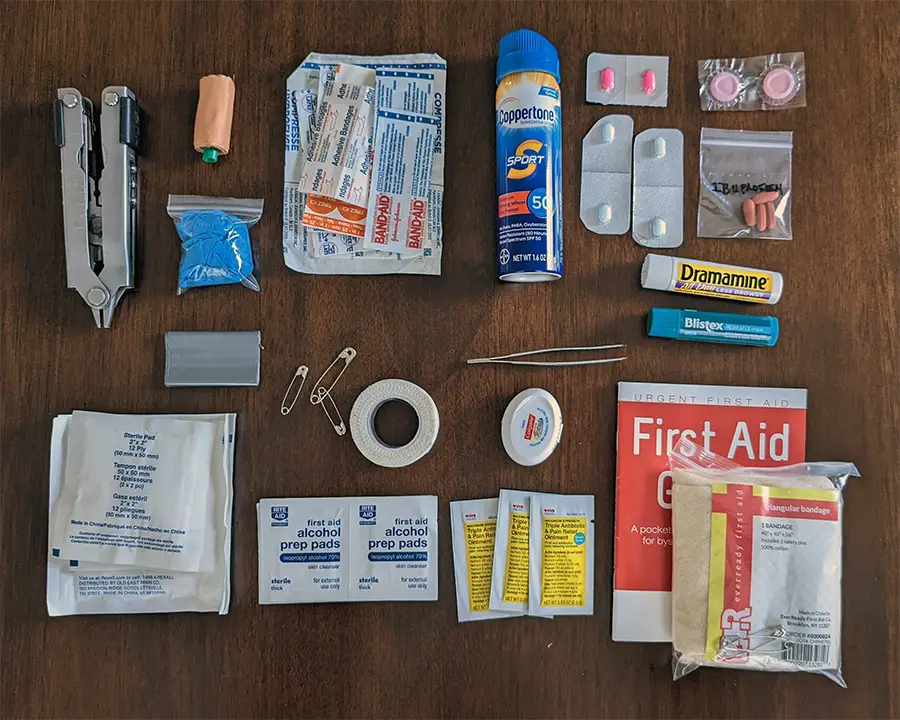
I grouped some items together into zip-lock bags to keep things better protected and organized.
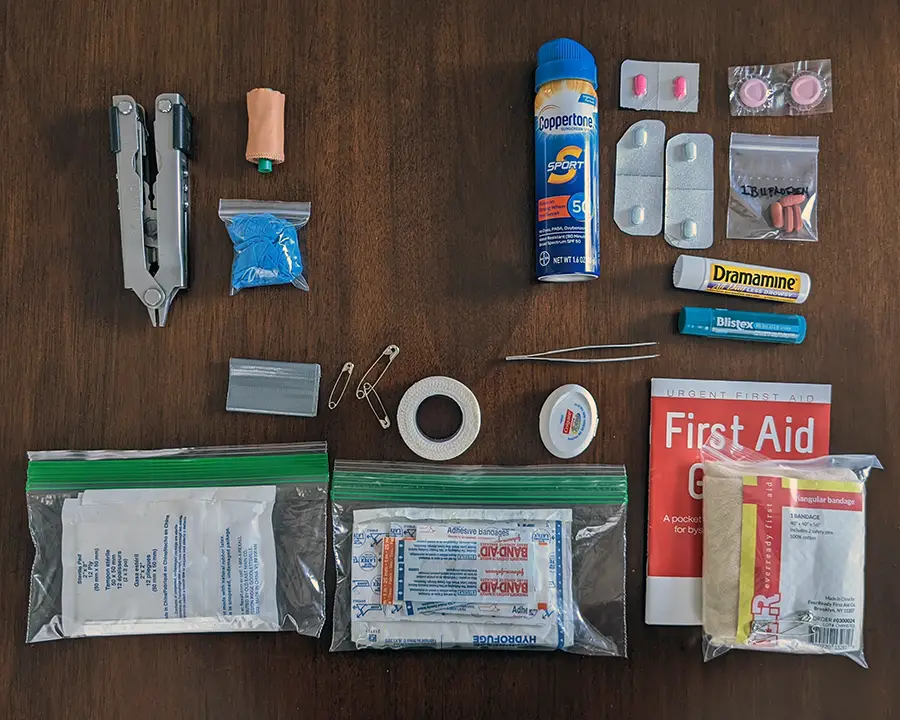
Everything fit fine, but I keep the multitool either on my belt or on my PFD.
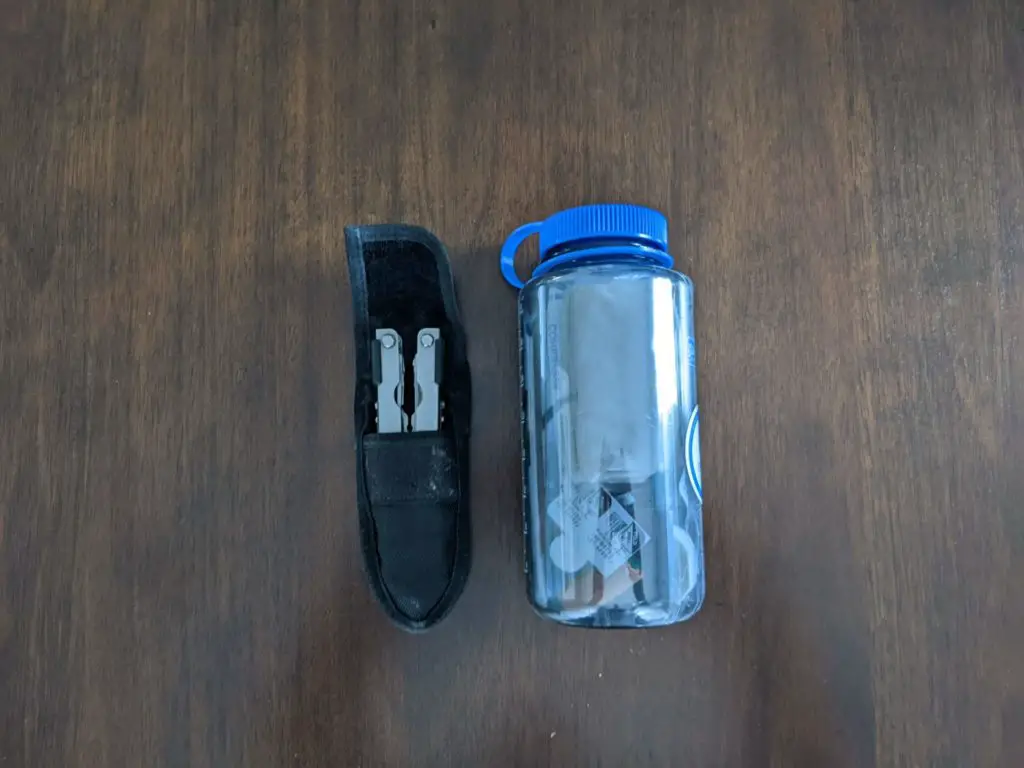
Best first aid kits for kayaking
If building your own kit isn’t for you, we’ve chosen a few great options.
The NRS Paddler Medical Kit is the best overall choice for someone who wants a more comprehensive kit. The company says it is good for 1-6 people for up to 7 days. When rolled up, the bag is about 10″x11″.
The NRS Ultra Light Paddler Medical Kit is a scaled-down version of the previous medical kit. It’s less expensive, and is good for 1-2 people for up to 4 days, is about 7″x14 1/2″ and weighs around half a pound.
The GPUSFAK 2-in-1 Waterproof First Aid Kit was the best budget-friendly first aid kit I could find suitable for kayak, canoe, and other small boats with the majority of what you are looking for. It also includes several survival items as well.
What kind of first aid kit do you carry in your canoe or kayak? Let us know in the comments.

